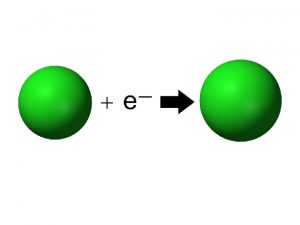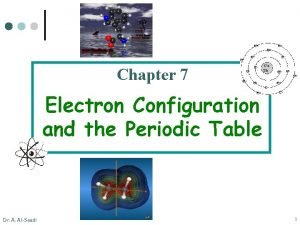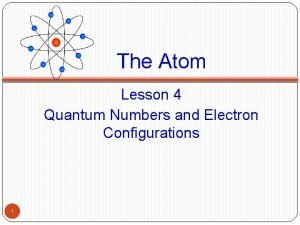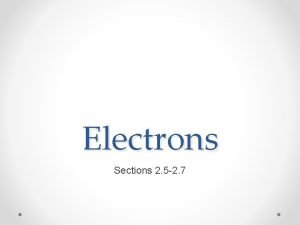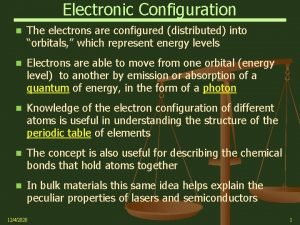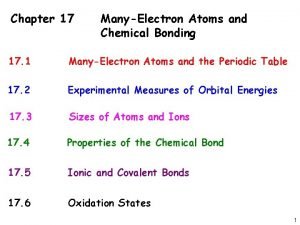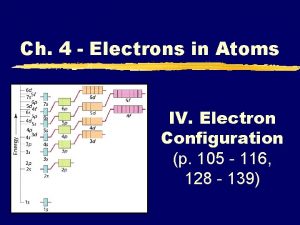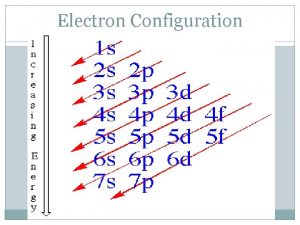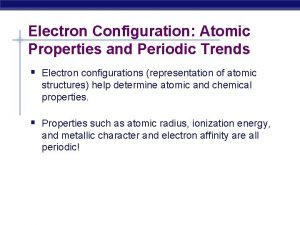Electron Configuration and Periodic Trends Essential Question How
















- Slides: 16

Electron Configuration and Periodic Trends

Essential Question How do Aufbau’s Principle, the Pauli Exclusion Principle, and Hund’s Rule dictate the arrangement of electrons in an atom

Electron Configuration • The arrangement of electrons in an atom is its electron configuration • Every element will have a unique electron configuration because they all have different numbers of electrons

Ground State Electron Configuration Electrons in an atom tend to assume arrangements that have the lowest possible energies. This is called the electrons ground state electron configuration.

Rules Governing Electron Configuration Aufbau Principle states that an electron occupies the lowest energy orbital that can receive it.

Rules Governing Electron Configuration Pauli Exclusion Principle states that for two electrons to occupy the same orbital, they must have opposite spin states

Rules Governing Electron Configuration Hund’s Rule states that orbitals of equal energy are occupied by one electron before any orbital is occupied by a second electron, and all electrons in singly occupied orbitals must have the same spin state.

Arrangement of The Atom All atoms are made up of : Principle energy levels- 1 -7 (periods on the periodic table) represented by n=1 Each principle energy level contains sublevels (S, P, D, F) Each sublevel contains orbitals (S-1, P-3, D-5, F-7) Each orbital can hold a maximum of 2 electrons Sublevels Orbitals S P D F 1 3 5 7 Maximum Electrons 2 6 10 14

Writing Electron Configuration

Writing Electron Configuration Draw the electron configuration chart and use it to write the unabbreviated electron configurations for the following elements. Lithium Aluminum iron

Writing Electron Configuration Draw the electron configuration chart and use it to write the abbreviated electron configurations for the following elements using the noble gas notation. Lithium Aluminum iron

Determining Elements from Electron Configurations Use the electron configuration to determine the names of the elements. 1 s 22 p 63 s 23 p 4 [Xe]6 s 24 f 145 d 6

Writing Electron Configuration

Writing Electron Configuration Use the periodic electron configuration chart and use it to write the unabbreviated electron configurations for the following elements. Lithium Aluminum iron

Writing Electron Configuration Use the periodic electron configuration chart and use it to write the abbreviated electron configurations for the following elements using the noble gas notation. Lithium Aluminum iron

 Electron configuration vs noble gas configuration
Electron configuration vs noble gas configuration Periodic table trends electron affinity
Periodic table trends electron affinity Periodic table electron configuration
Periodic table electron configuration Electron configuration periodic table
Electron configuration periodic table Trends in the periodic table
Trends in the periodic table How to find out group and period of an element
How to find out group and period of an element Costa's levels of questioning
Costa's levels of questioning Quantum numbers and electron configuration
Quantum numbers and electron configuration Iodine valency
Iodine valency 5s 25p6 is the outermost electronic configuration of
5s 25p6 is the outermost electronic configuration of Line spectrum and continuous spectrum difference
Line spectrum and continuous spectrum difference Diamagnetic elements
Diamagnetic elements Orbital diagram for k
Orbital diagram for k 8 electron configuration
8 electron configuration Stability and electron configuration ch 4
Stability and electron configuration ch 4 Quantum mechanical model and electron configuration
Quantum mechanical model and electron configuration Relative configuration
Relative configuration

